Nova Scotia International Tattoo July 1- 8 2014- Halifax, Nova Scotia
--------
Beloved Queen Elizabeth II and our Governor General of the Commonwealth of Canada- David Johnston
---------------
and some days..
---------------
O Canada
----------------
Canada's World Class Olympian Clara Hughes biking across Canada 4 'Let's Talk Mental Health Canada' and our Terry Fox, who in the 70s proved.... Cancer would never stop him from running- walking across Canada and living his dream... u both raise the world of humanity in our eyes... thank u. God bless our Canada-
--------------
July 1-8 International Tattoo- Halifax Nova Scotia- come getcha world class global military gala on... bring your children and your inner child.
------------
God bless the Islamic Republic of Afghanistan - we love u... God bless Dr. Abdullah Abdullah who actually stayed side by side with the actual everyday Afghans... and our Nato troops who truly believed in the everyday Afghan people... and died, wounded and fight the fight proving it.
D-Day
honour
----
---------------
For all the sheeeet we can't change.... and the little bit we can.... here's 2 animals, and kids... and watermelon wine....
...2 all those waiting.... we'll see ya soon.... and Rita MacNeil ... looking 4ward 2 some kitchen music with Johnny, Waylon, Keith Whitley and the boys.... and Stomping Tom... behave yourself... just cause u can outdrink God don't mean u got to...
... and 2 all the soldiers, friends, tramps and thieves and families.... which includes most of ya.... 2 day we are holding our soldiers of suicide real close and hugging our wounded and loving our children a whole lot...
have a great week.... have been blogging and writing since 2001 because of September 11, 2001- and am still here.... now our brave hearts are almost home.... and we are thankful.... it's time 2 build up our Canada and make her strong and educate our children and fix our own.... imho... have a great week...
... an old song my Uncle - that old war dog used 2 love especially when he was in his cups....
OLD DOGS AND CHILDREN AND ... WATERMELON WINE
AND ONE OF MINE.... SAMMY DAVIS... MR. BOJANGLES
WE ARE CANADIAN SOLDIERS
AND OUR TROOPS LOVE...\
THE WOLVES- save the environment- save our world 4 the future generations- IDLE NO MORE CANADA
We are Canadian Soldiers
Lord Help Me Jesus
Anne Murray- A Little Good News
The Serenity Prayer- am a friend of bill w. Peace of Christ and love brothers and Sisters. Been there, done that... and somehow survived 2 tell the tale- God helps His tattered and tarnished angels... and holds His arms out waitin on us 2 wander the heavens in joy, and love and redemption and renewal's sweet sounds.... Peace of Christ everyone... and u that have no religion... Peace of Christ anyway...
God grant me the serenity to accept the things I cannot change; courage to change the things I can; and wisdom to know the difference. Living one day at a time; Enjoying one moment at a time; Accepting hardships as the pathway to peace; Taking, as He did, this sinful world as it is, not as I would have it; Trusting that He will make all things right if I surrender to His Will; That I may be reasonably happy in this life and supremely happy with Him Forever in the next. Amen.
SUNDAY MORNING COMING DOWN
The Serenity Prayer- am a friend of bill w. Peace of Christ and love brothers and Sisters.
God grant me the serenity to accept the things I cannot change; courage to change the things I can; and wisdom to know the difference. Living one day at a time; Enjoying one moment at a time; Accepting hardships as the pathway to peace; Taking, as He did, this sinful world as it is, not as I would have it; Trusting that He will make all things right if I surrender to His Will; That I may be reasonably happy in this life and supremely happy with Him Forever in the next. Amen.
SUNDAY MORNING COMING DOWN
http://www.youtube.com/watch?v=vbqGWTxwZEA
-----------------
------------
B’ fhearr leam an cuil le caileig!
TOM AYERS CAPE BRETON BUREAU
Last Updated April 3, 2014 - 8:14pm
If you can read this, you likely think you have a way with the lassies
SYDNEY — A pair of events this weekend should go a long way to dispelling one stereotype of Gaelic culture as dour and austere.
Sure, Gaels can throw a kitchen party like no one else, but there’s still a common image of stoic individuals who lack colour. A workshop on Saturday and a new book of naughty Gaelic words and phrases being released this weekend should show that the Gaelic language can be fun to learn.
“A lot of times, we talk about Gaelic in historical terms … and that contributes to the impression that it’s old-fashioned and Victorian,” said Heather Sparling, chieftain (vice-president) of the Cape Breton Gaelic Society.
Sparling said the group’s Fun With Nouns session set for Saturday at the New Dawn Centre for Social Innovation — the former Holy Angels convent — is aimed at people who have at least a little of the Gaelic.
The daylong workshop will be run by well-known Gaelic teacher Kathleen Reddy of St. Francis Xavier University in Antigonish.
Reddy likely won’t be teaching people to cuss like the devil, but the day should be fun.
“What she will do is teach, basically, a grammar session, which sounds unfun, but using Gaelic idioms which can be very useful and colourful,” said Sparling, also a Cape Breton University music professor.
“Instead of being an old-fashioned drill exercise … we’ll be using the unique aspects of the language and the culture. Things like ‘as sick as a dog’ or stuff like ‘Oh, I nailed it.’ That’s an idiom we use in English, and it literally means one thing, but we use it in another context.
“In order to learn the richness of a language, you want to learn those idioms.”
Cape Breton University Press has just published The Naughty Little Book of Gaelic (All the Scottish Gaelic You Need to Curse, Swear, Drink, Smoke and Fool Around), by Michael Newton, and it’s in Nova Scotia bookstores this weekend.
Some of the words and phrases in the book are reasonably tame, but others are fairly salty. Sparling said that’s OK, because a language has to be used commonly to be learned.
“That includes curse words and off-colour jokes. If we really think about it, those are part of our English language, and Gaelic does have that as well.
“Part of the problem, too, is you don’t learn that kind of language in class at first. Any language, any culture, has to exist and for it to survive and be vibrant; it has to exist in everyday usage.”
Sparling said she took some Gaelic language classes on the Isle of Skye, where “you’re dealing with teenagers and they’re swearing all the time.”
Gaelic language classes in the past have meant rote memorization, which gives people a technical understanding of the language but not an understanding of everyday usage, she said.
“What we really need is to bring the language into the bars, into the kitchens, into the places where people are.”
Information on Fun With Nouns can be found on Facebook — search for the Cape Breton Gaelic Society — or by emailing Sparling.
The Naughty Little Book of Gaelic is available at most chain and independent book stores, said Cape Breton University Press editor Mike Hunter.
THE NAUGHTY LITTLE BOOK OF GAELIC:
The book contains an editor's note that reads: The content herein is uncensored and does not reflect the ideas or opinions of the author, illustrator, editors or publisher. It includes graphic and/or suggestive language not suitable for all readers. Contemporary readers may be offended by some expressions of gender and sexuality.
We have selected some of the translations that are printable in a family newspaper.
Cursing:
Buinneach o’n teine ort!
May you suffer diarrhea from the fire!
Swearing:
A mhic an uilc!
O son of evil!
Snuff/tobacco:
a’ gabhail toit
Taking a smoke
Drinking:
uisge-beatha
The water of life; the origin of the English word “whisky”
Sex:
Cho cinnteach is a tha bod’s an each
As sure as the horse has a penis
http://thechronicleherald.ca/novascotia/1197947-b-fhearr-leam-an-cuil-le-caileig
--------------
Abused Children's Peace Monument-Toronto Canada- the only one on the planet
-----------
He's Got The Whole World In His Hands....
U Are a Child of the Universe u Matter- Desiderata- Max Ehrmann- 1927
Go placidly amid the noise and haste, and remember what peace there may be in silence. As far as possible without surrender be on good terms with all persons. Speak your truth quietly and clearly; and listen to others, even the dull and the ignorant; they too have their story. Avoid loud and aggressive persons, they are vexations to the spirit. If you compare yourself with others, you may become vain and bitter; for always there will be greater and lesser persons than yourself. Enjoy your achievements as well as your plans. Keep interested in your own career, however humble; it is a real possession in the changing fortunes of time. Exercise caution in your business affairs; for the world is full of trickery. But let this not blind you to what virtue there is; many persons strive for high ideals; and everywhere life is full of heroism. Be yourself. Especially, do not feign affection. Neither be cynical about love; for in the face of all aridity and disenchantment it is as perennial as the grass. Take kindly the counsel of the years, gracefully surrendering the things of youth. Nurture strength of spirit to shield you in sudden misfortune. But do not distress yourself with dark imaginings. Many fears are born of fatigue and loneliness. Beyond a wholesome discipline, be gentle with yourself. You are a child of the universe, no less than the trees and the stars; you have a right to be here. And whether or not it is clear to you, no doubt the universe is unfolding as it should. Therefore be at peace with God, whatever you conceive Him to be, and whatever your labors and aspirations, in the noisy confusion of life keep peace with your soul. With all its sham, drudgery, and broken dreams, it is still a beautiful world. Be cheerful. Strive to be happy.
--------------
-----------
------------
BEST BLOG: CLARA'S BIG RIDE- Mental Health Matters 2014
Students and youth are stepping up Canada- Fighting Mental Illness in the light- let's git r done - COME AND JOIN US CANADA- MENTAL ILLNESS LIVES IN ALL OUR HOMES
http://nova0000scotia.blogspot.ca/2014/03/students-and-youth-are-stepping-up.html
COMMENT:
Yes,
this made national news a few months ago I think. A mosque shipped up to the
Canadian Arctic. To me, it genuinely does encapsulate what Canada is like to
peaceful Muslim-Canadians.
There
is national Canadian comedy series on tv that just ended after several years:
“Little Mosque on the Prairie”.
Some
notable Canadians accomplished in their fields and who just happen to be
Muslim:
http://www.thestar.com/comment/columnists/94618
He is a distinguished journalist. You can see his articles. He’s won national
awards. A managing editor for one of Canada’s largest city newspapers
(Toronto).
http://www.calgarymayor.ca/
Mayor of the city where I live. He is Muslim Canadian. Harvard educated, highly
articulate and personable. He is a small “c” conserative, so he doesn’t
threaten the oil firms that rule our province but he will speak out. Because of
his style, younger generation are drawn to him/his ideas and others who are
tired of entrenchment of the status quo for years.
He did
electrify the rest of Canada with his municipal win because our province has a
reputation to be more rednecek/right wing than other provinces.
ARTICLE
Saudi
Arabia/Canada: Little Mosque in the Artic
Posted
on April 30, 2012 by American Bedu
This
tantalizing trailer shares the journey of a mosque to a group of Muslims who
live in the Artic Circle.
arcticmosque
-------------
--------- Canada Armed Forces, Militia, Reservists and Rangers- O Canada- from around the world
CANADA'S FLAG BABY!
Canada Flag - Description
National flag of Canada has two vertical bands of red (hoist and fly side, half width) with white square between them; an 11-pointed red maple leaf is centered in the white square
Canada Flag - History
At the time of Confederation, Canada's national flag remained the Union Jack. However, Sir John A. Macdonald, Canada's first Prime Minister, flew the Canadian Red Ensign as a distinctive flag of Canada. Following the Second World War, in 1945, an Order in Council authorized the flying of the Canadian Red Ensign from federal government buildings, in Canada and abroad. In 1964, Prime Minister Lester B. Pearson made the creation of a new Canadian flag a priority. After eliminating thousands of proposals, the Special Committee on a Canadian Flag was left with three possible designs: one incorporating three red maple leaves with blue bars (nicknamed the "Pearson Pennant"), a flag with a single stylized red maple leaf on a white square with red bars, and another version that contained both the Union Jack and three fleurs-de-lis. On January 28, 1965, the National Flag of Canada was proclaimed by Her Majesty Queen Elizabeth II, to take effect on February 15, 1965. The inspiration for a red and white flag came from Dr. George Stanley, Dean of Arts at the Royal Military College in Kingston, Ontario. Impressed by the Commandant's flag at the College (a mailed fist holding three maple leaves on a red and white ground), Dr. Stanley suggested to Mr. John Matheson a similar design with a single red maple leaf at the centre. This red - white - red pattern bore a strong sense of Canadian history: the combination had been used as early as 1899 on the General Service Medal issued by Queen Victoria.
Canada Flag - colors & Symbolism
Red color is a symbol of Canadian sacrifice during World Wars.
White is the symbol of peace and tranquility reflecting neutrality and impartiality of Canadians
Well before the coming of the first European settlers, Canada's Aboriginal peoples had discovered the edible properties of maple sap, which they gathered every spring. According to many historians, the maple leaf began to serve as a Canadian symbol as early as 1700. In 1860, at a public meeting held in Toronto, the maple leaf was adopted as the national emblem of Canada for use in the decorations for the Prince of Wales' visit. Red and white were designated as Canada's official colours in 1921 by His Majesty, King George V, in the proclamation of the Royal Arms of Canada.
Canada Flag - Facts
In 1982, Laurie Skreslet, a skier from Calgary, took the Canadian flag to the highest point on Earth, Mount Everest.
In 1984, the Canadian flag reached new heights when it blasted into space on the flight mission uniform of Marc Garneau, the first Canadian astronaut in space.
When the Canadian flag flies along with the flags of the 10 provinces and 3 territories, the flags of the provinces and territories follow in the order that they entered Confederation. For those years when multiple provinces entered Confederation, their flags are arranged by size of population at time of entry. The order of precedence is therefore as follows: Ontario (1867), Quebec (1867), Nova Scotia (1867), New Brunswick (1867), Manitoba (1870), British Columbia (1871), Prince Edward Island (1873), Saskatchewan (1905), Alberta (1905), Newfoundland and Labrador (1949), Northwest Territories (1870), Yukon (1898) and Nunavut (1999).


Nova Scotia- CANADA'S EARLIEST MAP - 1558
_ The poppies by Iqaluit seamstress Atsainak Akeesho features carefully trimmed rabbit fur dyed red and a black sealskin centretp-inuit-fur-poppy
Nova Scotia Lobster
---------------------
THE NATIONAL FLAG OF CANADA
FROM THE UNION JACK TO THE MAPLE LEAF
Notes
The national flag of Canada, popularly known as the Maple Leaf Flag (or, in French, l'Unifolié or "one leafed") is one of the world's most recognizable and, from a design standpoint, one of the most successful of all national flags. Yet though the Canadian confederation was created in 1867, and though Canada has been a fully independent country since the early twentieth century, it was only in 1965 that the Maple Leaf Flag was adopted. Canada's history as a confederation of provinces with very different origins and traditions—and, in particular, the inclusion of Francophone Québec—made the adoption of a flag a sensitive political issue. For a long time Canada had no distinctive national flag at all. The British Union Jack was the official national flag, and the Canadian Red Ensign was used as an unofficial, eventually quasi-official, flag of national identity. Between 1867 and 1965 there were hundreds of proposals for a new Canadian flag, many of which played a part in the long process that eventually produced the Maple Leaf Flag. Canada's vexillogical heritage is thus one of the richest and most varied in the world.
Note on the Flags of Québec: Francophone Canada—Québec and the French-speaking communities in other parts of the country—has a vexillogical heritage all its own. To avoid making this page too cumbersome, the flag history of Francophone Canada will appear as a separate page in a future update of HISTORICAL FLAGS OF THE WORLD.
FIRST FLAGS OVER CANADA | |
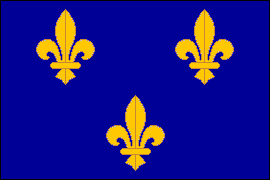
THE ROYAL BANNER OF
FRANCE
| |
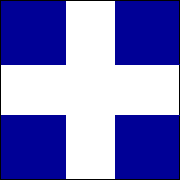
FRENCH MERCHANT
ENSIGN
Early 17th Century |
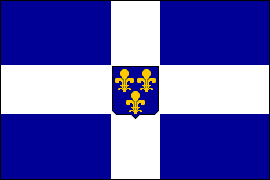
FRENCH MERCHANT
ENSIGN
18th Century |
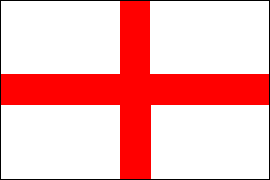
THE CROSS OF ST. GEORGE
|
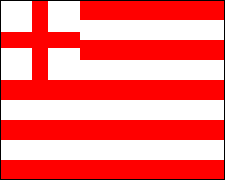
ENSIGN OF THE EAST INDIA
COMPANY
|
|
The first flags to be flown over
the lands that became Canada were those of the rival colonial powers: France and
Britain. The early French explorers no doubt bore the French Royal Banner, and
later the various French naval and merchant ensigns became a familiar sight in
Canadian waters. The Cross of St. George was the first English flag to make its
appearance, and in 1610 when the English explorer Henry Hudson sailed into the
immense bay that was to be named after him, his ship, the Discovery, may
have flown an early version of the ensign of the East India Company, which financed his final (and
fatal) expedition in search of a Northwest
Passage.
| |
|
THE UNION JACK IN
CANADA
| |
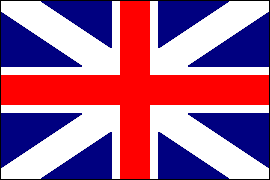
FIRST UNION FLAG •
1606-1801
|
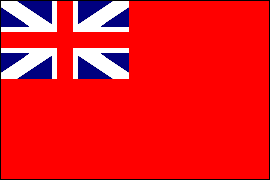
THE METEOR FLAG •
1707-1801
|
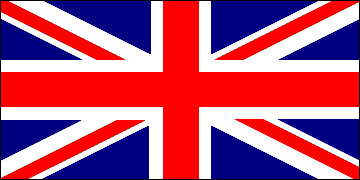
THE ROYAL UNION FLAG SINCE
1801
|
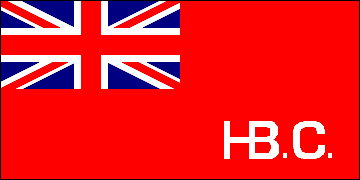
HUDSON'S BAY COMPANY
FLAG
|
|
As in the territory of
the future United States, the British Union Flag, popularly known as the Union Jack,
was colonial Canada's national flag. From 1606 to 1801, the Union Jack combined
the crosses of SS. George and Andrew, symbolizing the union of England and
Scotland in the Kingdom of Great Britain. In 1801, when Ireland was added to
create the United Kingdom of Great Britain and Ireland, the diagonal Cross of
St. Patrick was added to create the current Union Jack. This remained Canada's
official national flag until 1965, when the Maple Leaf Flag was adopted. It was
however, retained as an official Canadian flag (the Royal Union Flag) and it is
flown together with the Maple Leaf Flag on designated days and certain
occasions, e.g. the Queen's Birthday and Commonwealth Day. Except on the
occasion of a royal visit, the Maple Leaf Flag takes precedence over the Royal
Union Flag.
Of the Union Jack's
numerous variants, the Red Ensign was also frequently seen in colonial Canada.
Popularly known as the Meteor Flag, it was an ensign of the Royal Navy from 1707
to 1864 and the British civil ensign thereafter. Along with the British Blue
Ensign, this flag was adapted for numerous colonies of the British Empire,
usually by adding a badge in the fly. In Canada, the Hudson's Bay Company used a
Red Ensign with the its initials in the lower
fly.
| |
| THE CANADIAN RED ENSIGN | |
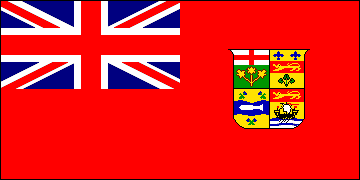 1892-1922 | |
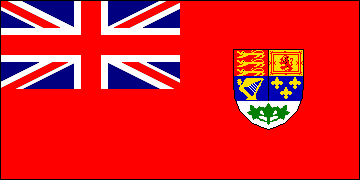
1922-57
|
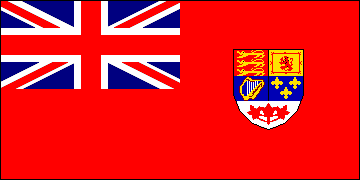
1957-65
|
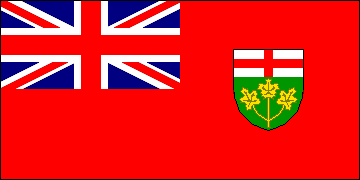
PROVINCE OF ONTARIO SINCE
1965
| |
|
In 1868, a year after the
creation of the Canadian confederation, a Great Seal for Canada, combining the
arms of the provinces of Ontario, Québec, Nova Scotia and New Brunswick, was established by royal
warrant. Soon thereafter, this device was applied to the British Red Ensign to
create a distinctive Canadian flag. Though for many years it enjoyed no official
recognition, this flag quickly became popular and in 1892 it was belatedly
confirmed as Canada's civil ensign. Though intended purely for use at sea, the
Canadian Red Ensign was widely flown on land as well and soon came to be
regarded as Canada's de facto national flag. In the 1920s the Canadian
government authorized it to be flown by the Canadian High Commission in London
and the Canadian Embassy in Washington, DC. During World War II, the government
directed the Canadian Army overseas to use it as a flag of nationality when
appropriate. In 1945, a Canadian order in council authorized the Canadian Red
Ensign to be flown on government buildings inside and outside Canada pending the
adoption of a definitive Canadian national flag.
There were three official
versions of the Canadian Red Ensign. In 1922 Canada's new coat of arms replaced
the great seal, and in 1957 the maple leaves in the base of the shield were
changed from green to red, white and red being Canada's livery colors. The
Canadian Red Ensign's long career came to an end in 1965, with the adoption of
the current national flag. In Manitoba and Ontario, however, sentiment in favor
of the Union Jack remained strong, and in 1965-66 they both adopted provincial
flags based on the Red Ensign.
| |
| PROPOSALS FOR A NEW CANADIAN FLAG | |
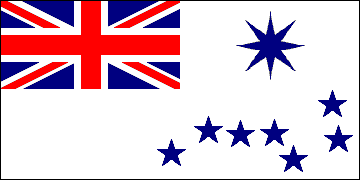
1930 PROPOSAL
| |
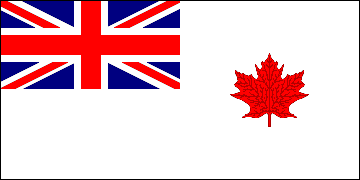 |
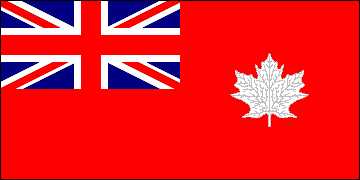 |
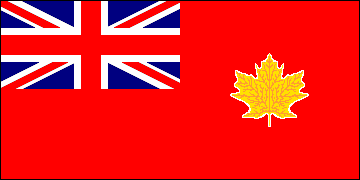 1946 JOINT PARLIAMENTARY COMMITTEE PROPOSALS | |
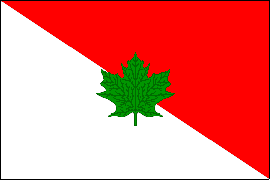 GODBOUT'S 1947 PROPOSAL |
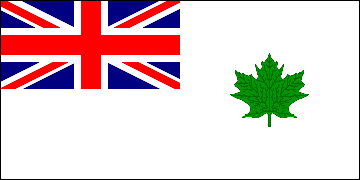 HOLLINGSWORTH'S 1955 PROPOSAL |
|
In the years following
confederation, and particularly after World War I, there were numerous proposals
for a distinctive Canadian flag. Most of them were based on the Union Jack and
many incorporated the maple leaf, which had come to be accepted as a symbol of
Canada after its appearance in the coat of arms of Ontario, but none ultimately
found favor. The inclusion of Francophone Québec in the confederation was the primary
complicating factor, but even among English-speaking Canadians there were
divisions of opinion between those who cherished the British connection and
those who wished to emphasize a purely Canadian national identity. One
interesting design proposed in 1930 drew inspiration from the Australian flag,
which depicts the Southern Cross constellation. The Canadian proposal, like the
much later state flag of Alaska, displayed the Big Dipper, plus a "confederation
star." In 1946 a parliamentary joint committee formed for the purpose of
selecting a new flag for Canada recommended a Red Ensign with a golden yellow,
white-bordered maple leaf in place of the Canadian arms. But Francophone
Canadians were opposed to any new flag that retained the Union Jack and the
prime minister, Mackenzie King, shelved the committee's proposal.
Francophone Canadians
were generally in favor of a national flag whose symbolism was neutral: Canadian
rather than British or French. Adélard Godbout, a former premier of
Québec suggested in 1947 that a flag diagonally
divided from upper hoist to lower fly, red over white, charged with green maple
leaf, would make an acceptable Canadian flag. This was in fact the flag of the
of the League of the Canadian Flag, an organization devoted to the adoption of a
distinctive flag for the nation. Godbout's proposal pointed the way forward,
incorporating the elements of the future Canadian flag: the colors red and
white, and the maple leaf. But the Red Ensign remained popular with many
English-speaking Canadians. When Liberal MP A. H. Hollingworth introduced a
bill for the adoption of a new flag in 1955, he thought it essential that the
Union Jack be retained. The white field of his proposed flag was intended to
appeal to Francophone Canadians, white being the color of royalist France. But neither these flags
nor the many other designs proposed in the 1950s found favor, and the Canadian
Red Ensign soldiered on.
| |
| THE GREAT CANADIAN FLAG DEBATE | |
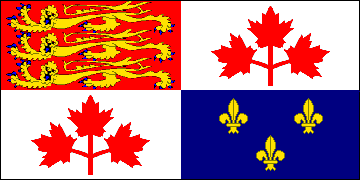 1964 PROPOSAL |
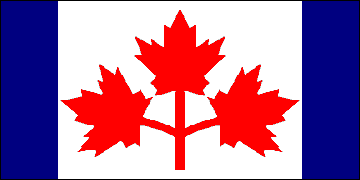 THE PEARSON PENNANT |
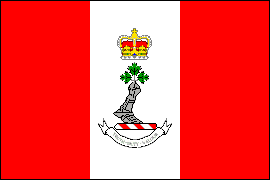 ROYAL MILITARY COLLEGE OF CANADA | |
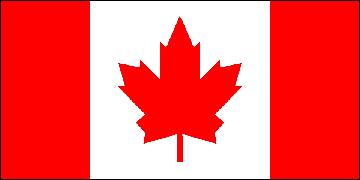 |
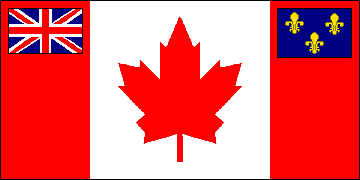 |
|
Group B Finalist
1964 PARLIAMENTARY COMMITTEE
DESIGNS Group C Finalist
| |
|
The long-running flag
debate came to a head in 1964 when the new Liberal Prime Minister, Lester
Pearson, placed the issue before Parliament. Pearson, who had campaigned on the
promise of a new flag for Canada, favored a design with the three red maple
leaves from the Canadian arms on a field of white between two vertical blue
stripes. This flag had the advantages of being distinctively Canadian, of
incorporating the colors of the Union Jack, of including blue for Francophone
Canada and of suggesting the national motto: "From Sea to Sea." But the Pearson
Pennant, as it came to be called, had the disadvantage of being too closely
associated with Pearson and the Liberals. John Diefenbaker, leader
of the Progressive Conservatives and former prime minister, not only opposed the
Pearson Pennant but argued strongly that the Red Ensign should be retained. The
result was an extended and acrimonious parliamentary debate. Finally a committee
of fifteen MPs was formed to consider the large number of proposals. The flag
eventually selected was designed by George F.G. Stanley and inspired by the flag
of the Royal Military College of Canada. The committee considered two variants:
one with a red maple leaf on a white field between two vertical red stripes and
one with the Union Jack and the Banner of France added. Both variants had 1:2
proportions, with each red stripe taking up a quarter of the flag's total area.
Stanley's original, simple design (Group B Finalist) was approved unanimously by
the committee on 29 October 1964, and adopted by a majority vote in the House of
Commons on 15 December 1964. The Senate's approval came two days
later.
| |
| THE MAPLE LEAF FOREVER | |
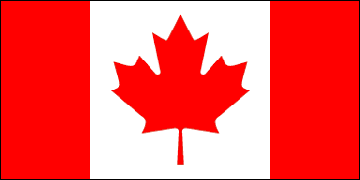 NATIONAL FLAG SINCE 1965 |
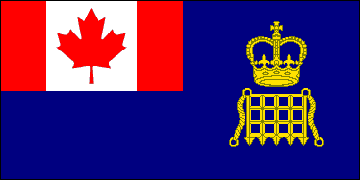 CANADIAN CUSTOMS ENSIGN |
|
As finally adopted,
the new flag was slightly modified to depict an eleven-point maple leaf. In this
form it was submitted to Queen Elizabeth II for her royal assent, which was duly
given on 28 January 1965. The Maple Leaf Flag was officially hoisted for the
first time on 15 February 1965. The ceremony took place on
Parliament Hill, Ottawa, in the presence of the Governor General of Canada, the
Prime Minister, the members of the Cabinet, and members of Parliament. At the
stroke of noon, the Canadian Red Ensign was lowered and the Maple Leaf Flag was
raised. The crowd then sang "O Canada" followed by "God Save the
Queen."
Since 1965, a number
of Maple Leaf Flag variants have been adopted, mostly by the armed forces. An exception is
the ensign of Canadian Customs, which is similar to the British customs ensign,
with the Maple Leaf Flag replacing the Union Jack.
| |
http://tmg110.tripod.com/canada_flag.htm
------------------
I Stand for Canada: The Story of The Maple Leaf Flag Hardcover
by Rick Archbold (Author)
Beautifully illustrated and dramatically told, this is the story of Canada’s most recognized visual emblem, its proudest national icon, and its most successful brand logo: the red maple leaf flag.
Our flag is seen by millions of Canadians every day and by millions more people around the world. Its elegantly simple design is instantly identifiable, whether worn as a shoulder patch on the uniform of a Canadian peacekeeper or held high by the athlete chosen to lead Canada’s team into the Olympic stadium.
At home, we encounter the maple leaf symbol wherever we look: along the Trans-Canada Highway, at the entrance to national parks, flying over more than 20,000 federal government offices, in the skies on Air Canada planes. From bacon and beer to berets and badges, the stylized red maple leaf has become our nation’s most successful brand and visual emblem.
I Stand for Canada chronicles the evolution of the maple leaf as Canada’s pre-eminent symbol, from its first appearance in French colonial times to its ubiquitous 21st-century presence, central to the corporate identity programs of countless companies and organizations. The distinctive shape of the native sugar maple leaf was familiar to every settler of New France and then of British North America; it was the first emblem of the St. Jean Baptiste Society, founded in 1834, and in 1860 it was incorporated into the badge of the Royal Canadian Regiment. By Confederation, it was a widely accepted motif for the new nation; that year Alexander Muir composed “The Maple Leaf Forever,” which served as its informal anthem. The majority of badges worn by soldiers of the Canadian Expeditionary Force in World War I incorporated the maple leaf into their design, and the Canadians who fought in Europe under a British flag returned home with a newly minted sense of national identity, made material by the maple leaf emblems they’d worn into battle.
Parliament’s first two attempts to establish a distinct Canadian flag, in 1925 and 1946, ended in stalemate, and it was not until 1964, when the nation was almost a century old, that Prime Minister Lester Pearson dared to inaugurate the political debate that would decide the issue. The entire country got into the fight, and the flag threatened to divide the country instead of bringing it together. In desperation, Pearson agreed to turn the decision over to an all-party committee, which considered several thousand possible designs, including offerings from the Group of Seven’s A.J. Casson and A.Y. Jackson.
After the longest debate in Canadian parliamentary history, the House of Commons voted to adopt the flag committee’s surprisingly successful compromise. On February 15, 1965, Canada’s official flag was raised for the first time on Parliament Hill. In the 37 years since, the maple leaf flag has become our symbol of national pride, the unique and perfect Canadian logo – and Canadians, for all their supposed reticence, have become a nation of exuberant flag-wavers.
I Stand for Canada is the first comprehensive work on the origins, evolution, political history, and cultural significance of Canada’s flag, one that combines rare archival illustrations and stunning contemporary images with a richly detailed and engaging narrative.
------------------------
CANADA 40 facts about our flag- FROM 2007
In Canada and around the world, the National Flag is our collective nametag. This is Canada, it says, in beaming white and red. And this year, our flag turned 43. So, in honour, we have compiled 40 facts about what it is, where it came from and the hype that has sometimes followed it.
By Global National
It flies at the top of the Peace Tower on Parliament Hill and is sewn on the backpacks of globetrotting Canadians. It's wrapped around triumphant athletes and waved by children at Canada Day parades, coast to coast. It's on mugs, pins and car bumpers. In Canada and around the world, the National Flag is our collective nametag. This is Canada, it says, in beaming white and red. And this year, our flag turned 43. So, in honour, we have compiled 40 facts about what it is, where it came from and the hype that has sometimes followed it.
1. Feb. 15 1965: Canada's new red and white Maple Leaf flag was raised for the first time on Parliament Hill. Maurice Bourget, Speaker of the Senate, addressed the audience. "The flag is the symbol of the nation's unity, for it, beyond any doubt, represents all the citizens of Canada without distinction, language, belief or opinion."
2. The official name is the National Flag of Canada.
3. The flag at the Peace Tower flies 24 hours a day, seven days a week. It is changed on a daily basis, usually early in the morning and by a designated Parliament Hill building employee who receives training on how to perform the task.
4. Flags on the East and West Block are changed weekly.
5. Once a flag is drawn, it goes to the office of the Minister of Public Works and Government Services, before it is eventually distributed to people who have requested it.
6. Want one? You'll have to be patient. There is a 10-year waiting list to receive a flag that has flown on the Peace Tower. The wait is five years for a flag that has flown on the East or West Block. Anyone interested should put the request in writing and send it in: by mail to Public Works and Government Services Canada, Office of the Minister 18A1, Portage Place III, 11 Laurier St., Gatineau, Que., K1A 0S5; by fax to: (819) 953-1908 or by e-mail to minister@pwgsc.gc.ca. Only one flag per household is allowed.
7. New flags are kept in the basement of Centre Block.
8. National Flag Day: Feb. 15
9. So far this year, the government has purchased 32,900 flags, to be distributed to the public and members of Parliament on days like National Flag Day and Canada Day.
10. The flags are supplied by two companies -- one in Toronto called Flying Colours International and another in St-Foy, Que., that goes by the name Drapeaux et Bannieres L'etendard Inc. Both contracts cost the government a total of $907,129.95.
11. It takes about a week, from start to finish, to make a batch of Canadian flags at Toronto's Flying Colours International. The company uses high tenacity nylon that is made in Kingston and woven into fabric in a Quebec factory. The fabric is stripped of oil before it is printed with a water-based dye.
12. The largest Canadian flag ever made, according to Flying Colours International, was recently unveiled at a football game in Hamilton, between the Hamilton Tiger-Cats and Toronto Argonauts. The flag was 38 metres by 76 metres, and required at least 80 pairs of hands to carry it on to the field. This flag will never fly -- it's too big -- but it will be brought on to the turf at Ivor Wynne Stadium, the Ticat's home base, for the start of every home game. A flag that size costs $15,000.
13. It doesn't get much smaller than the tiny plastic Canadian flag lapel pins that are often given away by the government. For decades they were made by a company in Toronto. In 2003, the government awarded the contracts to two importers who outsourced the job to China. When that news became public this year, the government promised to ensure that some flag pins are made in Canada.
14. The government gave away a million flags after the Quebec referendum. It was a plan hatched by Sheila Copps, then heritage minister, to promote national unity. The freebies ended up costing the government $15-million.
15. Bloc Quebecois MP Suzanne Tremblay was criticized in 1998 after complaining that too many Maple Leaf flags were displayed by the Canadian delegation at the Winter Olympics in Nagano, Japan.
16. The Peace Tower flag is 2.25 metres by 4.5 metres.
17. The search for a new Canadian flag actually started in 1925 when a committee of the Privy Council began to research possible designs for a national flag. However, the work of the committee was never completed.
18. Later, in 1946, a select parliamentary committee was appointed with a similar mandate, called for submissions and received more than 2,600 designs. Still, the House of Commons was never called upon to vote on a design.
19. Prime Minister Lester B. Pearson reignited the search for a new flag in 1964. By October a committee had shortlisted three possible designs -- a Red Ensign with the fleur-de-lys and the Union Jack, a design incorporating three red maple leaves, and a red flag with a single, stylized red maple leaf on a white square. (Mr. Pearson preferred a design with three red maple leaves between two blue borders.)
20. The combination of red, white and red first appeared in the General Service Medal issued by Queen Victoria.
21. The flag is red and white, the official colours of Canada as appointed by King George V in 1921, with a stylized 11-point red leaf in its centre. It is twice as long as it is wide.
22. It's not just any red. The printing ink colour is FIP red: General Printing Ink, No. 0-712; Inmont Canada Ltd., No. 4T51577; Monarch Inks, No. 62539/0; or Sinclair and Valentine, No. RL163929/0. The painting colours are FIP red No. 509-211 and white: 513-201.
23. Flag etiquette stipulates that when the National Flag of Canada is raised or lowered, or when it is carried in a parade or review, all present should face the flag, men should remove their hats and all should remain silent. Those in uniform should salute.
24. In 1999, a school board trustee at Winnipeg School Division No. 1 ordered all custodians to take better care of Canadian flags that fly over city schools after he found one crumpled up and tossed into a box of muddy boots. Mario Santos, who immigrated to Canada from Portugal in the 1960s, instructed custodians to raise the flag at 8:30 a.m., take it down at 3:30 p.m., and store it carefully and respectfully within the school.
25. The Trade Marks Act protects the National Flag of Canada against unauthorized use. Requests to use the flag should be made to the Department of Canadian Heritage. A sketch of the intended use must be submitted by fax. The flag cannot be defaced by way of printing or illustrations or masked by other objects.
26. It caused a stir in the 1992 World Series between the Toronto Blue Jays and the Atlanta Braves when the U.S. Marine Corps carried it upside down at the pre-game ceremony. The Jays won the game 5-4.
27. It caused another late last year, when Newfoundland and Labrador Premier Danny Williams ordered the flags lowered to protest an "unacceptable" offer from the federal government regarding off-shore royalties. "The Premier's actions are disrespectful of our most treasured national symbol," Prime Minister Paul Martin said.
28. But that wasn't the only time the flag was dragged into politics. The Mayor of Quebec City ordered the Canadian flag removed from atop City Hall after the failure of the Meech Lake accord. The flag would return in 1998.
29. The National Flag does not fly outside the Quebec legislature, unless there is a special federal ceremony.
30. In 2002, Quebec swimmer Jennifer Carroll waved the Quebec fleur-de-lys flag rather than the Maple Leaf while on the podium at the Commonwealth Games.
31. A Reform party motion to allow MPs to display the Canadian flag on their desks in Parliament was defeated in 1998, after dominating Commons debate for several weeks.
32. When provincial and territorial flags are flown with the National Flag of Canada, the order is based on the date of entry into Confederation of the provinces followed by the territories.
33. Flags are flown at the half-mast position as a sign of mourning. The flag is brought to the half-mast position by first raising it to the top of the mast then immediately lowering it slowly to the half-mast position.
34. If a flag is tattered and no longer suitable to fly, proper etiquette calls for a dignified destruction. The suggestion: burn it privately.
35. In 1999, students at the University of Brandon burned the Canadian flag to protest against Canadian troops in East Timor.
36. In 2001, then Quebec premier Bernard Landry compared the Canadian flag to "bits of red rag" used to provoke bulls.
37. The National Flag of Canada should always be flown on its own mast -- flag protocol dictating that it is improper to fly two or more flags on the same mast (eg. one beneath the other). Further, the following points should be kept in mind:
38. It should not be used as table/seat cover, as a masking for boxes or as a barrier on a dais or platform. Nothing should be pinned to or sewn on the National Flag of Canada. The National Flag of Canada should not be signed or marked in any way. (A border could be attached to the edge of the flag on which it would be acceptable to have signatures, leaving the flag itself untouched.)
39. Chris Hollingworth of St. Albert, Alta., refused to remove a Canadian flag from the window of his condo in 2001, after the building's manager called it "aesthetically unpleasing." Hollingworth had placed it there after the Sept. 11 attacks against the United States.
40. On the day he was sworn in as prime minister, Paul Martin clutched the Canadian flag that flew at half mast on the Peace Tower on Sept 14, 1992, the day his father died. Paul Martin Senior was a Cabinet minister in the Trudeau government.
http://www.canada.com/globaltv/national/story.html?id=4d297c89-5675-4f20-b801-21e1eda67e7d








.png)


























.jpg)



















No comments:
Post a Comment
Note: Only a member of this blog may post a comment.